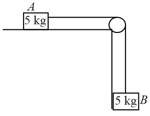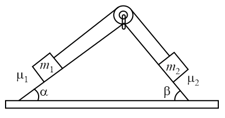MEDIUM
Agniveer Vayu
IMPORTANT
Earn 100
A variable force acts on a body of mass kept on a rough horizontal surface . The velocity of the body at is,
(a)
(b)
(c)
(d)
20% studentsanswered this correctly

Important Questions on Laws of Motion
MEDIUM
Agniveer Vayu
IMPORTANT
A block of mass , resting on a horizontal surface, is connected by a cord, passing over a light frictionless pulley to a hanging block of mass . The coefficient of kinetic friction between the block and the surface is . Tension in the cord is [Take ]

MEDIUM
Agniveer Vayu
IMPORTANT
The direction of force of friction is:
EASY
Agniveer Vayu
IMPORTANT
A block of mass and surface area just begins to slide down on an inclined plane, when the angle of inclination is . Keeping the mass same, the surface area of the block is doubled. The angle at which it starts sliding down is
MEDIUM
Agniveer Vayu
IMPORTANT
Two blocks of masses and connected by a string are placed gently over a fixed inclined plane, such that the tension in the connecting string is initially zero. The coefficient of the friction between and inclined plane is , between and the inclined plane is . The tension in the string shall remain zero if

EASY
Agniveer Vayu
IMPORTANT
EASY
Agniveer Vayu
IMPORTANT
EASY
Agniveer Vayu
IMPORTANT
EASY
Agniveer Vayu
IMPORTANT
